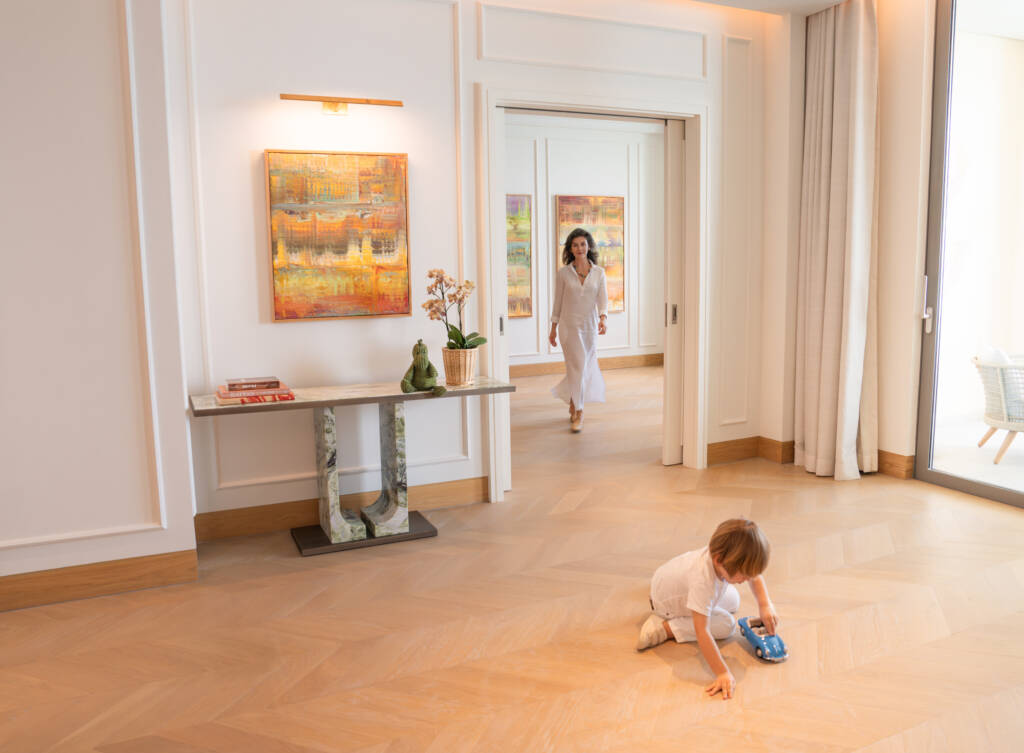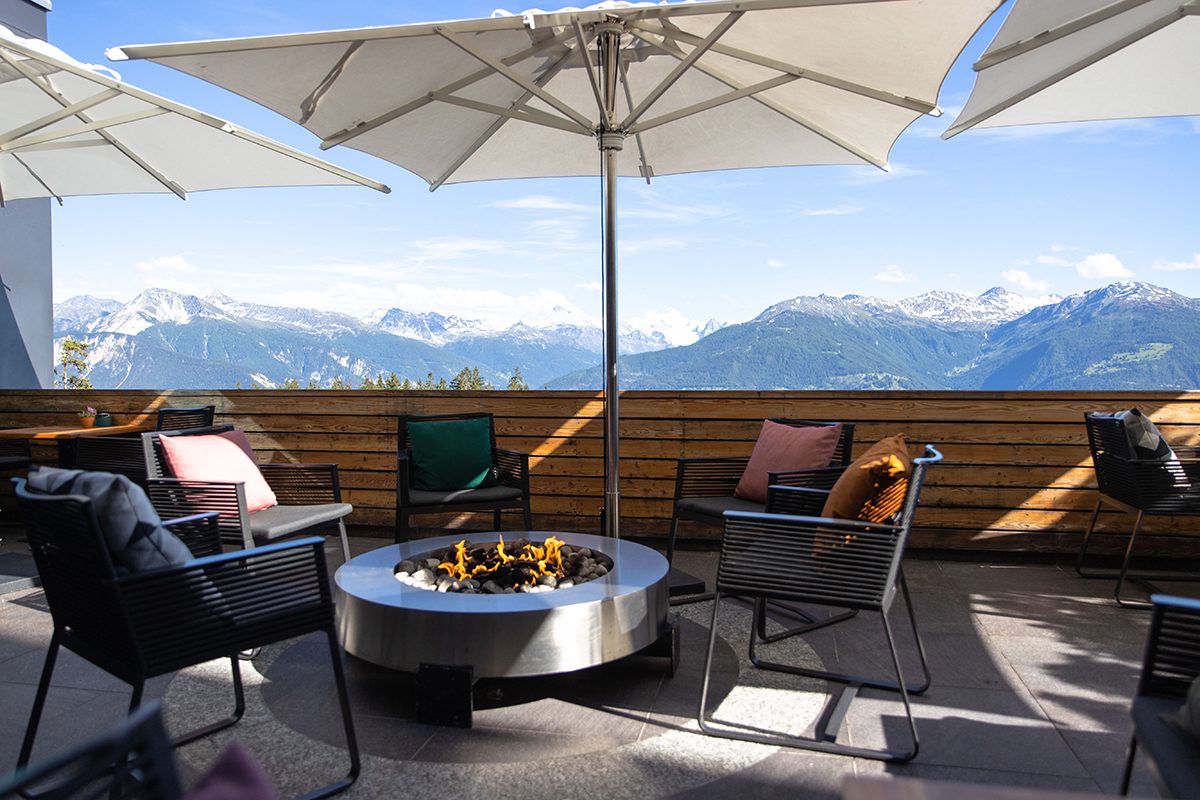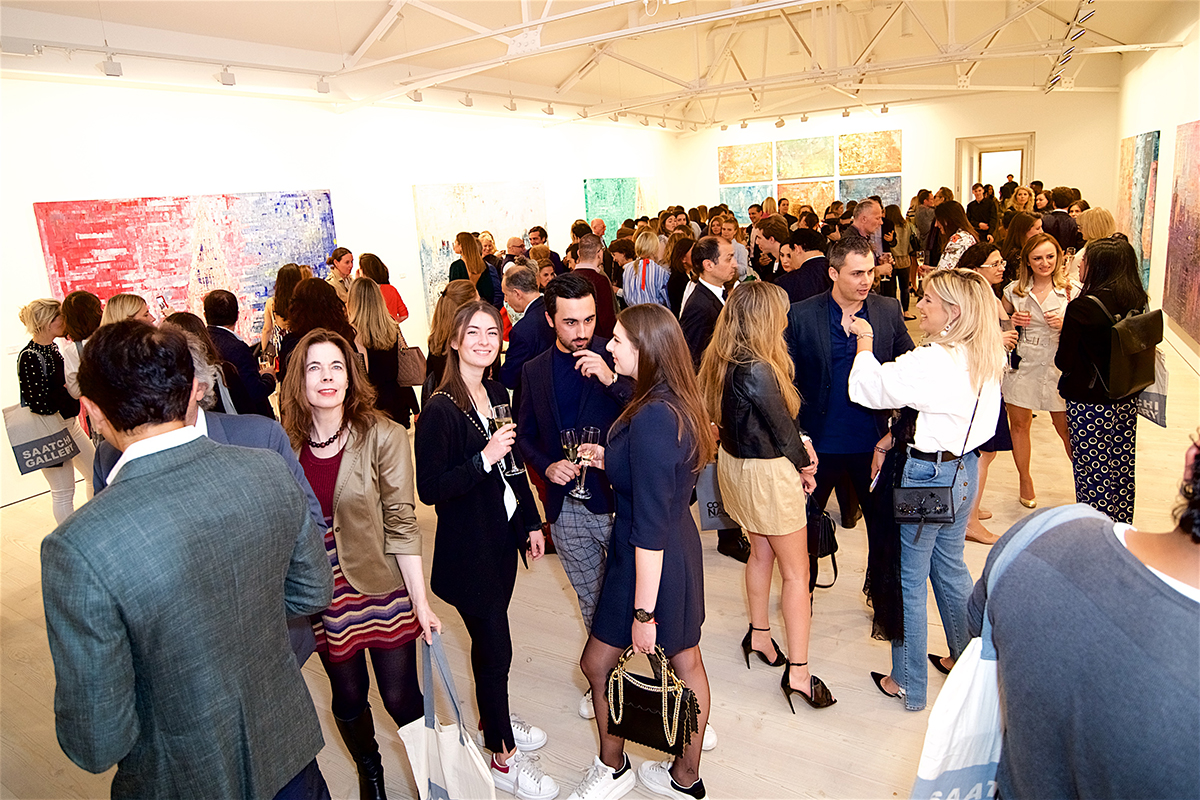
The artist Sassan Behnam-Bakhtiar meditating in the Amarta space by James Turrell, during his Patina Maldives residency in January and February 2024
French-Iranian artist Sassan Behnam-Bakhtiar is renowned for his abstract works hinting at a paradise with a twist. On the eve of the artist’s residency at an eco-luxury resort in the Maldives, the Italian collector Andrea Morante, former CEO of the Pomellato jewellery brand, which was acquired by Kering in 2013, tells LUX about why Behnam-Bakhtiar’s works have stirred his collection
It all started over a dinner with LUX’s Editor-in-Chief, Darius Sanai. He was standing – very serious, with a bottle of the Tuscan wine Masseto in hand – going on about its virtues in absolute terms, as he does… my gaze drifted behind him, to a beautiful painting I hadn’t seen before.
I decided right there that I had to know the artist: it turned out to be Sassan Behnam-Bakhtiar. There was an immediate connection when I first met the artist, in the south of France where he was then based. A great dialogue soon started, perhaps because of my own childhood spent in Iran, which extended to all facets of life choices, family complexities, Iranian roots and personal sufferance.

Andrea Morante is an art collector and the former chief executive officer of Pomellato (the fifth largest European jewellery company) which was acquired by Kering in 2013
From the very beginning, the pleasure of visiting Sassan’s atelier was shared with my partner, Caroline. It was not only limited to sharing a common attraction to Sassan’s original signature style of peinture raclée, involving scraping, relaying and spreading blends of colour, it extended to a healthy competition on who would first spot the preferred work of art to acquire. (The competition continues after six years across Sassan’s artistic evolution.)
Follow LUX on Instagram: luxthemagazine
One visit, I was looking at a specific artwork immediately respectfully signed the painting with the name of the yacht. The mutuality of the collector-artist – blue and white in colour. The blue reminded me of a gentle summer day, the white seemed a reminder of its dramatic change – all of a sudden the sea can turn into rough waves.
And, while looking at it, by utter coincidence, I saw through the window next to it the yacht I was very sad to have just sold. I felt that the yacht, Cyrano de Bergerac, was waving goodbye with one of her masts. Sassan understood, and immediately respectfully signed the painting with the name of the yacht. The mutuality of the collector-artist – blue and white in colour. The blue reminded me of a gentle summer day, the white seemed a reminder of its dramatic change – all of a sudden the sea can turn into rough waves.
Artist Sassan Behnam-Bakhtiar with two of his works. He is a French – Iranian artist. Born in Paris in 1984, he lived in Tehran as a teenager and young adult. Many of his works are well-known for exploring his visionary and philosophical views on life and humanity.
And, while looking at it, by utter coincidence, I saw through the window next to it the yacht I was very sad to have just sold. I felt that the yacht, Cyrano de Bergerac, was waving goodbye with one of her masts.
Sassan understood, and 18 relationship has been formative, I think, for both sides. I used to travel frequently to Brazil to collect contemporary art, like that of João Câmara. Before that I’d stuck to 18th- and 19th- century Neapolitan gouaches, from Pietro Fabris to Pierre-Jacques Volaire.
Read more: Dakis Joannou interview in Hydra
But you think less about masters when you are in Brazil – there is no nostalgia there, and no very long historical track record. Spending time with artists, I found that some were destroying themselves, unable to cope with life.
Others were more able to find the balance between preserving artistic values and embracing the world of the commercial. I hoped that a collector might help with this issue, and that, conversely, the artists might also teach me.

Maria Behnam-Bakhtiar, wife of the artist, crafts luxurious interior designs.
“SASSAN IS ONE OF THOSE WHO FEEL IN THEIR BLOOD THAT SOMETHING MUST BE DONE TO CHANGE. IN HIS WORK, HE SEEMS TO ASK, ‘WHAT WORLD WILL
I LEAVE MY CHILD?’”
Sassan has done just this. In his work, and in his blue and whites, one feels the tug between pain and happiness. He has taught me how pain can be transformed from negative to positive energy, and how this makes all the difference. Sassan’s art, I think, has this disposition at the moment, perhaps associated with the arrival of his first child.

Energy in Nature, from the “Life Energy” series of miniature Living Paintings, 2024, by Sassan Behnam-Bakhtiar
Fatherhood seems to have translated onto his canvas. The stratified pain of darker colours have been gradually substituted by a calmer, more joyous, colour combination. Three of my favourite pieces of his work – coloured canvases uniquely characterised by the superimposition of an explosion of flowers – express this bold optimism. Its palpable effect is felt by many I know.
I recall a woman who, then pregnant, spoke about just how well in herself she felt seeing this work. He harnesses that power in art. When Pino Rabolini, the founder of Pomellato and a well-versed collector, was my mentor, I learned to work with artists who share the same principles and ethics.

Mixed Energy, from the “Life Energy” series of miniature Living Paintings, 2024, by Sassan Behnam-Bakhtiar
Sassan’s attention to sustainability is an inspiration for me. There are people for whom sustainability is a marketing scheme, and those who feel in their blood that something must be done to change. Sassan is one of the latter and we share that. Indeed, in some ways his fatherhood plays into this in his recent work.
“SASSAN HAS TAUGHT ME HOW PAIN CAN BE TRANSFORMED FROM NEGATIVE TO POSITIVE ENERGY, AND HOW THIS MAKES ALL THE DIFFERENCE”
He seems to ask himself, “What world will I leave my child?”. Sassan’s work keeps me company wherever I am. Here, in this chalet near Gstaad, where I am writing this piece from, the art is mostly tied to the mountains and snow, but two little Sassans sit behind me, looking beautiful and feeling comfortable in the mountains.

Energy in Nature, from the “Life Energy” series of miniature Living Paintings, 2024, by Sassan Behnam-Bakhtiar
I even used to have his paintings behind me on Zoom calls at work, and they were the source of many compliments. Thinking back on that dinner, shared with Darius all those years ago, it seems funny that we drank Masseto, of all wines: the company is almost exactly the same age as Sassan, who was born in 1984.
It feels only right, then, that I have a room dedicated solely to Sassan’s works at my place in Tuscany. Those wonderful colours talk to and blend in with one another, treading – with all his grace and elegance – Sassan’s tightrope walk of optimism from pain.

Soleil Couchant, from the “Life Energy” series of miniature Living Paintings, 2024, by Sassan Behnam-Bakhtiar
Sassan Behnam-Bakhtiar has recently completed a residency at the Patina Maldives, Fari Islands, and will be unveiling ‘Life Energy’, a new body of 20cm x 20cm miniature Living Paintings, created using sustainably sourced and natural materials during his time in the Fari Art Atelier. The series will be showcased at private gatherings in Doha and London, culminating at an exhibition and art sale at Patina Maldives in July. Sales proceeds will be donated to funding local marine conservation.




































Recent Comments